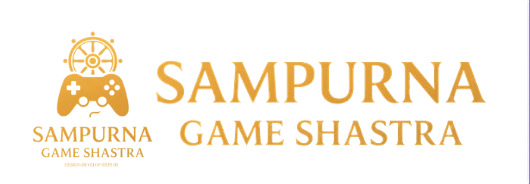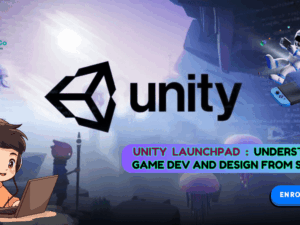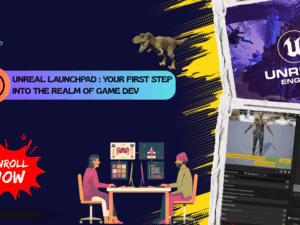Pixel to Polygon : The Blender Journey
- Description
- Curriculum
- FAQ
This hands-on 3-week Blender course is designed for beginners eager to master the essentials of 3D modeling, animation, lighting, and rendering using Blender. From setting up your workspace to creating polished animated scenes, this course guides you through a structured learning path that builds your skills progressively. By the end of the program, you will have developed a strong foundation and a portfolio-ready project demonstrating your ability to create engaging 3D environments and animations.
Course Highlights
- Beginner-Friendly Approach: No prior experience needed; perfect for aspiring 3D artists, animators, and game developers.
- Structured Learning Path: Weekly modules cover everything from basic modeling and texturing to advanced lighting, particle effects, and scene optimization.
- Project-Based Curriculum: Apply your skills through practical assignments and mini projects, culminating in a final animated scene.
- Industry-Relevant Skills: Learn workflows and tools used by professionals in animation, game design, and visual effects.
What You’ll Learn
- Blender Fundamentals: Installation, interface navigation, and workspace setup.
- Modeling & Texturing: Create simple to complex 3D models, UV unwrap, and apply realistic materials.
- Animation & Rigging: Animate objects using keyframes, rig simple mechanisms, and choreograph camera movements.
- Scene Composition: Arrange assets, set up lighting, and build interactive environments.
- Advanced Lighting & Effects: Utilize HDRI lighting, particle systems for smoke and rain, and volumetric effects.
- Polish & Optimization: Refine models, textures, and lighting for realism and optimize scenes for smooth rendering.
- Final Project: Integrate all skills to create and render a polished animated scene with multiple props, effects, and dynamic camera work.
Weekly Breakdown
| Week | Focus Area |
| 1 | Foundations & Modeling |
| 2 | Animation & Scene Assembly |
| 3 | Lighting, FX & Final Project |
Learning Outcomes
By the end of this course, learners will be able to:
- Confidently navigate Blender’s interface and tools.
- Model and texture a variety of 3D objects.
- Animate objects and cameras with keyframes and constraints.
- Compose scenes with lighting and particle effects for realism.
- Optimize scenes for efficient rendering.
- Produce a portfolio-ready animated project demonstrating comprehensive Blender skills.
Pixel to Polygon offers a fast-paced, practical introduction to Blender, equipping you with the knowledge and confidence to create stunning 3D content for animation, games, and visualization projects.
-
1Lec_1 : Getting Started with Blender – Installation, Workspace Setup, Navigation, and Basic Modeling
This lesson introduces Blender, guiding students through installation, workspace setup, and basic navigation. Participants will become familiar with the interface, learn essential modeling tools, and create a simple 3D object such as a table or crate, establishing a foundation for future modeling and animation work.
-
2Lec_2 : Modeling & Texturing
In this lesson, students will model a more complex object such as a chair, learn the process of UV unwrapping, and apply basic textures to their model. They will also practice exporting models in FBX or OBJ formats for use in other engines, building essential skills for 3D asset creation and integration.
-
3Lec_3 : Mini Project 1
In this hands-on project, students will assemble a furnished room scene using their own modeled assets. They will apply materials and textures to objects, organize the scene, and set up basic lighting in Blender to create a realistic and visually appealing interior. This lesson reinforces foundational skills in 3D modeling, texturing, and lighting.
-
4QUIZ : WEEK_1
-
5ASSIGNMENT : WEEK_1
-
6Lec_1 : Object Animation
In this lesson, students will model and rig a simple object such as a door with hinges. They will learn to animate the object—opening and closing the door—using keyframes in Blender, gaining foundational skills in 3D object animation and rigging.
-
7Lec_2 : Scene Composition
In this lesson, students will arrange assets to create a small interactive environment and will learn to animate camera paths for dynamic scene exploration. The session covers essential techniques in scene composition and basic animation for more engaging and visually appealing 3D environments.
-
8Lec_3 : Mini Project 2
In this hands-on project, students will complete an animated room scene featuring a working door and animated props. They will learn to choreograph camera movements and render a short animation or interactive walkthrough, applying key skills in animation, scene composition, and real-time rendering in Blender. This project reinforces foundational techniques in 3D animation and scene visualization.
-
9QUIZ : WEEK_2
-
10ASSIGNMENT : WEEK_2
-
11Lec_1 : Advanced Lighting & Effects
In this lesson, students will experiment with HDRI lighting and advanced lighting setups to create realistic environments. They will also learn to add simple particle effects such as smoke and rain using Blender’s FX tools, enhancing scene atmosphere and visual impact for animation and game assets.
-
12Lec_2 : Polish & Optimization
This lesson guides students through refining models, textures, and lighting for greater realism in their scenes. They will also learn to optimize their projects for smooth rendering and efficient performance, preparing their work for final presentation and professional use.
-
13Lec_3 : Final Mini Project
In this final project, students will create a small, animated scene featuring multiple props, visual effects, and dynamic camera movements. They will render their animation and review it for polish, applying all the modeling, animation, lighting, and cinematography skills learned throughout the course. This project serves as a portfolio-ready demonstration of their 3D animation expertise
-
14QUIZ : WEEK_3
-
15ASSIGNMENT : WEEK_3
Yes, it includes a compositor and motion tracking tools.


